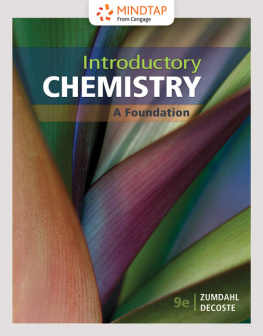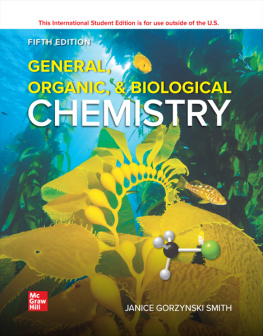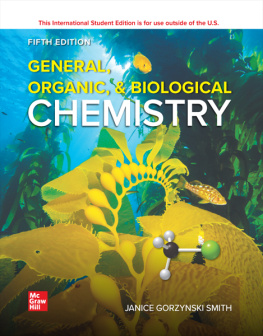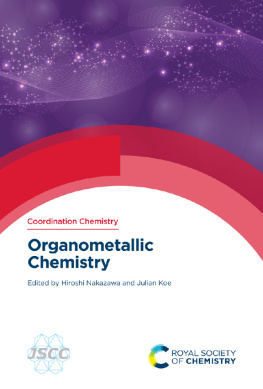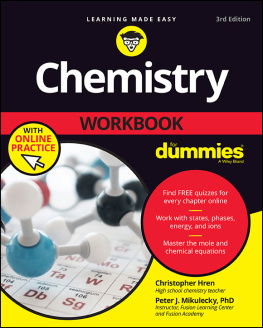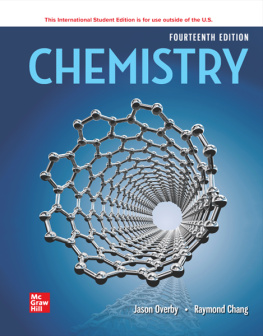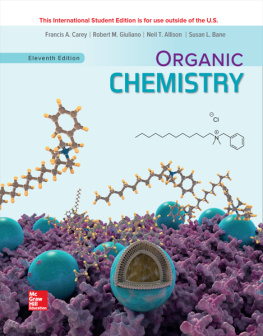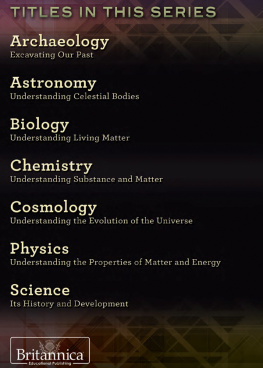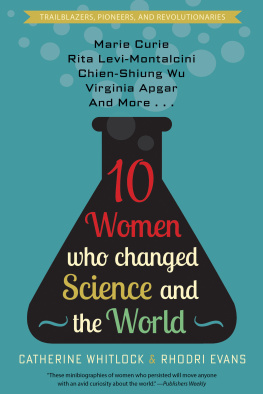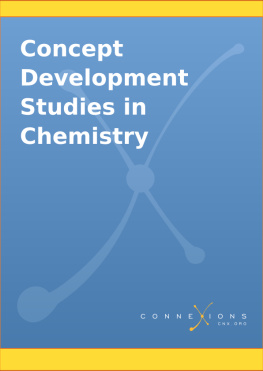DeCoste Donald J. - Introductory chemistry
Here you can read online DeCoste Donald J. - Introductory chemistry full text of the book (entire story) in english for free. Download pdf and epub, get meaning, cover and reviews about this ebook. City: Boston, MA.l., year: 2019, publisher: Cengage learning, genre: Children. Description of the work, (preface) as well as reviews are available. Best literature library LitArk.com created for fans of good reading and offers a wide selection of genres:
Romance novel
Science fiction
Adventure
Detective
Science
History
Home and family
Prose
Art
Politics
Computer
Non-fiction
Religion
Business
Children
Humor
Choose a favorite category and find really read worthwhile books. Enjoy immersion in the world of imagination, feel the emotions of the characters or learn something new for yourself, make an fascinating discovery.
- Book:Introductory chemistry
- Author:
- Publisher:Cengage learning
- Genre:
- Year:2019
- City:Boston, MA.l.
- Rating:3 / 5
- Favourites:Add to favourites
- Your mark:
- 60
- 1
- 2
- 3
- 4
- 5
Introductory chemistry: summary, description and annotation
We offer to read an annotation, description, summary or preface (depends on what the author of the book "Introductory chemistry" wrote himself). If you haven't found the necessary information about the book — write in the comments, we will try to find it.
Introductory chemistry — read online for free the complete book (whole text) full work
Below is the text of the book, divided by pages. System saving the place of the last page read, allows you to conveniently read the book "Introductory chemistry" online for free, without having to search again every time where you left off. Put a bookmark, and you can go to the page where you finished reading at any time.
Font size:
Interval:
Bookmark:
- 11.9. Electron Arrangements in the First Atoms on the Periodic Table
- Questions and Problems: 11.9 Electron Arrangements in the First Atoms on the Periodic Table
COPYRIGHT 2019, 2015 Cengage Learning
ALL RIGHTS RESERVED. No part of this work covered by the copyright herein may be reproduced or distributed in any form or by any means, except as permitted by U.S. copyright law, without the prior written permission of the copyright owner.
For permission to use material from this text or product, submit all requests online at www.cengage.com/permissions.
Further permissions questions can be e-mailed to .
Student Edition: ISBN: 978-1-337-39942-5
Loose Leaf Edition: ISBN: 978-1-337-39962-3
20 Channel Center Street
Boston MA 02212
USA
Cengage Learning is a leading provider of customized learning solutions with employees residing in nearly 40 different countries and sales in more than 125 countries around the world. Find your local representative at www.cengage.com.
Cengage Learning products are represented in Canada by Nelson Education, Ltd.
To learn more about Cengage Learning Solutions, visit www.cengage.com.
Purchase any of our products at your local college store or at our preferred online store www.cengagebrain.com.
The ninth edition of Introductory Chemistry continues toward the goals we have pursued for the first eight editions: to make chemistry interesting, accessible, and understandable to the beginning student. For this edition, we have included additional support for instructors and students to help achieve these goals.
Learning chemistry can be very rewarding. And even the novice, we believe, can relate the macroscopic world of chemistrythe observation of color changes and precipitate formationto the microscopic world of ions and molecules. To achieve that goal, instructors are making a sincere attempt to provide more interesting and more effective ways to learn chemistry, and we hope that Introductory Chemistry will be perceived as a part of that effort. In this text we have presented concepts in a clear and sensible manner using language and analogies that students can relate to. We have also written the book in a way that supports active learning. In particular, the Active Learning Questions, found at the end of each chapter, provide excellent material for collaborative work by students. In addition, we have connected chemistry to real-life experience at every opportunity, from chapter-opening discussions of chemical applications to Chemistry in Focus features throughout the book. We are convinced that this approach will foster enthusiasm and real understanding as the student uses this text. Highlights of the Introductory Chemistry program are described in the following section.
Building on the success of previous editions of Introductory Chemistry, the following changes have been made to further enhance the text:
We continue to emphasize chemical reactions early in the book, leaving the more abstract material on orbitals for later chapters. In a course in which many students encounter chemistry for the first time, it seems especially important that we present the chemical nature of matter before we discuss the theoretical intricacies of atoms and orbitals. Reactions are inherently interesting to students and can help us draw them to chemistry. In particular, reactions can form the basis for fascinating classroom demonstrations and laboratory experiments.
We have therefore chosen to emphasize reactions before going on to the details of atomic structure. Relying only on very simple ideas about the atom, Chapters 6 and represent a thorough treatment of chemical reactions, including how to recognize a chemical change and what a chemical equation means. The properties of aqueous solutions are discussed in detail, and careful attention is given to precipitation and acidbase reactions. In addition, a simple treatment of oxidationreduction reactions is given. These chapters should provide a solid foundation, relatively early in the course, for reaction-based laboratory experiments.
For instructors who feel that it is desirable to introduce orbitals early in the course, prior to chemical reactions, the chapters on atomic theory and bonding ( Chapters 11 and ) can be covered directly after Chapter 4 . Chapter 5 deals solely with nomenclature and can be used wherever it is needed in a particular course.
Problem solving is a high priority in chemical education. We all want our students to acquire problem-solving skills. Fostering the development of such skills has been a central focus of the earlier editions of this text, and we have maintained this approach in this edition.
In the first chapters we spend considerable time guiding students to an understanding of the importance of learning chemistry. At the same time, we explain that the complexities that can make chemistry frustrating at times can also provide the opportunity to develop the problem-solving skills that are beneficial in any profession. Learning to think like a chemist is useful to everyone. To emphasize this idea, we apply scientific thinking to some real-life problems in Chapter 1 .
One reason chemistry can be challenging for beginning students is that they often do not possess the required mathematical skills. Thus we have paid careful attention to such fundamental mathematical skills as using scientific notation, rounding off to the correct number of significant figures, and rearranging equations to solve for a particular quantity. And we have meticulously followed the rules we have set down so as not to confuse students.
Attitude plays a crucial role in achieving success in problem solving. Students must learn that a systematic, thoughtful approach to problems is better than brute-force memorization. We foster this attitude early in the book, using temperature conversions as a vehicle in Chapter 2 . Throughout the book we encourage an approach that starts with trying to represent the essence of the problem using symbols and/or diagrams and ends with thinking about whether the answer makes sense. We approach new concepts by carefully working through the material before we give mathematical formulas or overall strategies. We encourage a thoughtful, step-by-step approach rather than the premature use of algorithms. Once we have provided the necessary foundation, we highlight important rules and processes in skill development boxes so that students can locate them easily.
Section 8.4 : Learning to Solve Problems is written specifically to help students better understand how to think their way through a problem. We discuss how to solve problems in a flexible, creative way based on understanding the fundamental ideas of chemistry and asking and answering key questions. We model this approach in the in-text Examples throughout the text.
Many of the worked examples are followed by Self-Check Exercises, which provide additional practice. The Self-Check Exercises are keyed to end-of-chapter exercises to offer another opportunity for students to practice a particular problem-solving skill or understand a particular concept.
Font size:
Interval:
Bookmark:
Similar books «Introductory chemistry»
Look at similar books to Introductory chemistry. We have selected literature similar in name and meaning in the hope of providing readers with more options to find new, interesting, not yet read works.
Discussion, reviews of the book Introductory chemistry and just readers' own opinions. Leave your comments, write what you think about the work, its meaning or the main characters. Specify what exactly you liked and what you didn't like, and why you think so.

